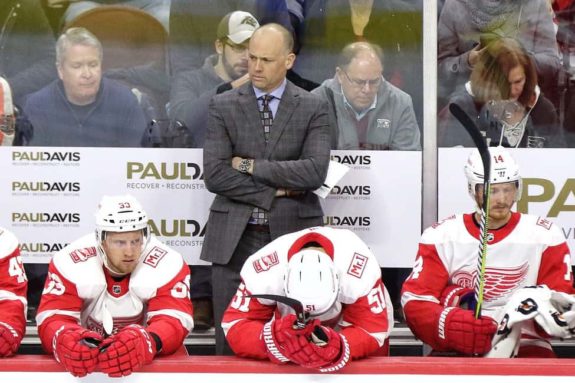Now that the regular season is over, it is time to reflect on it by looking at results and seeing how successful teams performed relative to expectations. A good way to determine this is by using the Pythagorean Expectation. The Pythagorean Expectation is a model I introduced in January that gives a team’s expected winning percentage by using goal differential.

The idea came from a similar model used in baseball using run differential. I took that basic idea and applied it to hockey using Goals For (GF) and Goals Against (GA) and then applying an exponent to it relative to the league’s scoring rates each season. The theory behind the model is that the greater a team’s goal differential (GF minus GA) the higher that team’s winning percentage should have been. That winning percentage can then be multiplied by 82 games to get an expected win total.
By knowing how many times a team was expected to win, we can see how well they performed relative to expectations. For example, if a team finished with fewer wins than expected, they underperformed relative to goal differential. This means their on-ice product was better than their record. The same works for a team with more wins than expected with a worse on-ice product than their record indicates.
On Friday, Apr. 13, I listed the three teams that most outperformed expectations in 2017-18. In this article, I will look at the teams that underperformed relative to expectations and whose records were worse than their goal differentials.
A Look at the Teams that Underperformed in 2017-18
This season, 16 of 31 teams underperformed. These included six playoff teams, including both Western Conference Wild Card teams, the Los Angeles Kings and Colorado Avalanche. Seven of the 16 underperforming teams had positive goal differentials including the Boston Bruins with the third-highest goal differential.

Additionally, all six of the teams with the five lowest point totals this season underperformed relative to their Pythagorean Expectations. These teams were the Buffalo Sabres, Ottawa Senators, Arizona Coyotes, Montreal Canadiens, Vancouver Canucks, and Detroit Red Wings. These teams also had the six worst goal differentials this season.
Although these teams had bad records, only the Red Wings were among the three teams that most underperformed this season. The other two teams were the Kings and Chicago Blackhawks.
Red Wings Not as Bad as Record Indicates
The Red Wings scored 217 goals and allowed 255, ranking 28th and 21st, respectively. Their minus-38 goal differential was the sixth-worst and with a 30-39-13 record, they underperformed relative to their Pythagorean Expectation by 4.5 percent.
Had they met their expectations, they would have won 34 games and the additional four wins is the biggest separation between expectation and reality for any team. One of the reasons the Red Wings underperformed was their lack of success in one-goal games.
In those games, they had a 10-14-13 record and two of those wins occurred in regulation. Those two regulation wins in one-goal games were the fewest by any team this season. Furthermore, 23 of Detroit’s 39 regulation losses were by two or fewer goals. Meanwhile, only two of their regulation losses were by five or more goals, both in December. On Dec. 2, they fell victim to the Canadiens 10-1 and on Dec. 9, they lost to the St. Louis Blues 6-1.

Of their 30 wins, 22 were in regulation with 11 by a margin of two or fewer goals. They had one win by five or more goals, an 8-2 victory over the Calgary Flames on Nov. 15. Low goal margins represented the Red Wings all season long. Out of their 37 one-goal games, in only 13 did either team score at least four goals.
Offensively, it makes sense why the Red Wings were part of so many low scoring games. They were in the bottom 10 in shooting and save percentages as well as power play and penalty kill success rates. They also only had two players with at least 50 points and two with 20-plus goals.
The 34 wins the Red Wings were expected to win were tied for sixth-fewest in the league with the New York Rangers. Even with those 34 wins, they would have still finished fifth in the Atlantic Division and missed the playoffs.
Kings Deserved Better than Wild Card Spot
The Kings scored 239 goals this season, 17th most, but allowed the fewest in the league with just 203 goals against. Their plus-36 goal differential was seventh-best and they qualified for the postseason as the Western Conference’s first Wild Card with a 45-29-8 record. Their Pythagorean Expectation says they should have won 48 games and that they underperformed by 4.1 percent.
Like most Kings teams in recent seasons, the 2017-18 team was elite at preventing goals and was adequate offensively. Their 239 goals were second-fewest among playoff teams and only the Anaheim Ducks scored fewer and reached the postseason. Of the Kings 29 regulation losses, 21 were by two or fewer goals and only two were by five or more. One was a 7-2 loss to the Blues on Mar. 10 and the second was a 5-0 shutout by the Nashville Predators on Feb. 1.

The Kings won 34 wins in regulation with 15 coming by two or fewer goals and three were by five or more, two against in-division foes, the Edmonton Oilers on Jan. 2 and the Coyotes on Feb. 3. Their third such win occurred against the Avalanche on Mar. 22 when they won 7-1.
Allowing so few goals means the Kings played an abundance of close games. In 33 one-goal games, they had a 14-11-8 record with three regulation wins. But even with a strong defense, they had a more potent offense than they had in recent seasons. This season they had three players with 60-plus points and three with at least 20 goals.
Had the Kings met their Pythagorean Expectation, they would have made a significant jump and their 48 wins would have been the seventh-most and they would have jumped from the first Wild Card team to second place in the Pacific Division.
Blackhawks Still in Central Division Basement
The Blackhawks missed the playoffs this season for the first time since 2008 and their future looks bleak. Finishing last place in the Central Division for the first time since the 2006-07 season, this year’s Blackhawks were not as bad as their 33-39-10 record conveys.
With a minus-27 goal differential, they actually played like a 36 win team, although that would not have changed their outcome. They still would have finished seventh in the division and nine wins behind the Western Conference’s second wild card team.

Chicago had the 10th worst offense this season, scoring 229 goals and tied for 10th worst in goals allowed with 256. Their goal differential was 12th worst and they played 3.6 percent behind their Pythagorean Expectation. The Blackhawks were generally a boom-or-bust team this season.
Of their 39 regulation losses, 21 were by three or more goals, including three losses by five or more. These included a 5-0 shutout loss to the Avalanche on Mar. 30 and a 6-1 loss at the hands of the Coyotes on Feb. 12. They had 26 regulation wins, 14 of which were by three or more goals. They also had three victories by five or more goals including a 10-1 beating of the Pittsburgh Penguins on Oct. 5 and a 7-1 victory over the Washington Capitals on Feb. 17.
There are many reasons why the Blackhawks struggled this season. One was their 8.2 shooting percentage that was fifth-worst and their .906 save percentage, 13th worst. They struggled offensively with just one player with at least 60 points. However, they did have five with 20 or more goals, tying them with the New York Islanders for most 20 goal scorers on a non-playoff team.
*All stats came from Hockey-Reference’s Play Index